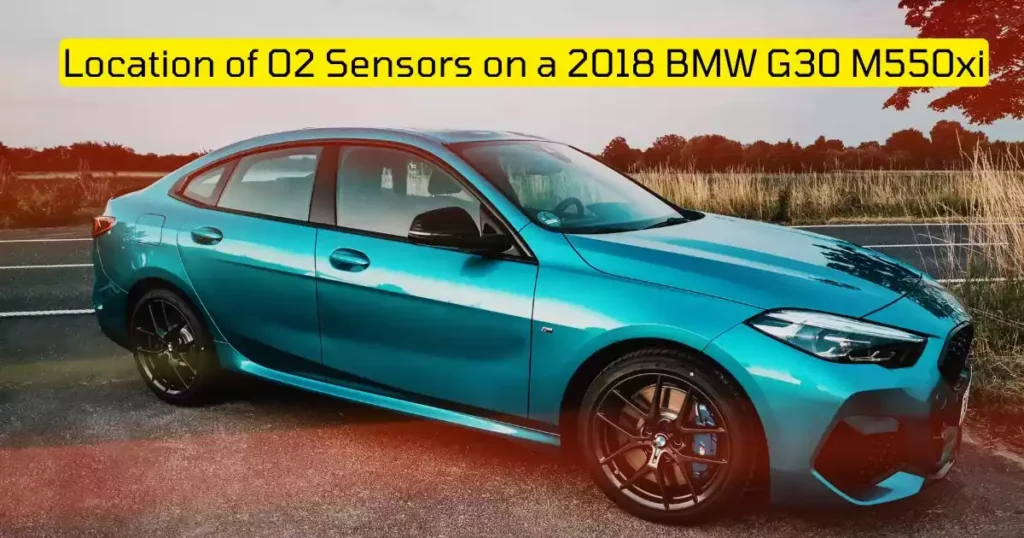The 2018 BMW G30 M550xi is a sophisticated luxury vehicle, combining performance, precision, and cuttingedgetechnology.
A critical part of maintaining this performance lies in the efficiency of the engine’s emission controlsystem, and the oxygen (O2) sensors play a vital role in ensuring optimal engine performance.
If you’re a BMW owner or someone interested in automotivemechanics, understanding the location of O2 sensors on a 2018 BMW G30 M550xi is essential. This comprehensive guide will cover the function, importance, and precise location of O2 sensors on the BMW G30 M550xi, along with maintenance and troubleshooting tips.

What Are O2 Sensors and Why Are They Important?
Before diving into the specifics of where the O2 sensors are located on the 2018 BMW G30 M550xi, it’s important to understand what these sensors are and their role in vehicle performance.
The Function of O2 Sensors
Oxygen sensors are critical components of the modern vehicle’s emission control system. They monitor the amount of oxygen in the exhaust gases, helping the engine control unit (ECU) adjust the air-fuel mixture for optimal combustion. By ensuring the engine burns fuel efficiently, O2 sensors help maintain fuel economy and reduce harmful emissions.
There are generally two types of O2 sensors in most modern vehicles, including the BMW G30 M550xi:
- Upstream O2 Sensors: These sensors are located before the catalytic converter and measure the oxygen content in the exhaust gases as they leave the engine.
- Downstream O2 Sensors: Positioned after the catalytic converter, these sensors check the exhaust gases post-filtration to monitor the converter’s effectiveness in reducing pollutants.
In the 2018 BMW G30 M550xi, the proper functioning of both upstream and downstream O2 sensors is crucial for the car’s performance, fuel efficiency, and compliance with emission standards.
Location of O2 Sensors on a 2018 BMW G30 M550xi
Now that we know the function of O2 sensors, let’s focus on the exact locations of these sensors on the 2018 BMW G30 M550xi.
Upstream O2 Sensors Location
The upstream O2 sensors in the BMW G30 M550xi are located near the engine’s exhaust manifold. The exhaust manifold is the component that collects the exhaust gases from the engine cylinders and directs them toward the catalytic converter.
In the case of the 2018 BMW G30 M550xi, the upstream O2 sensors are typically positioned on both sides of the engine block, close to where the exhaust manifold exits the engine. These sensors are the first line of defense in monitoring the oxygen content of the exhaust gases before they are processed by the catalytic converter.
To locate the upstream O2 sensors, you may need to raise the car and access the engine compartment, specifically around the exhaust manifold area. You’ll likely need a flashlight to spot them clearly, especially in the engine’s tight spaces.
Downstream O2 Sensors Location
The downstream O2 sensors are positioned after the catalytic converter, further along the exhaust system. These sensors serve a different purpose than the upstream sensors by measuring the effectiveness of the catalytic converter in reducing harmful emissions.
In the 2018 BMW G30 M550xi, the downstream O2 sensors are located under the vehicle, past the catalytic converter, and closer to the exhaust tailpipe. These sensors monitor the exhaust gases after they pass through the converter, checking for remaining oxygen content to ensure the catalytic converter is functioning properly.
To access the downstream O2 sensors, you’ll need to crawl under the vehicle, as they are positioned below the undercarriage. Again, using a flashlight will help locate these sensors in the dark or confined spaces under the car.
How Do O2 Sensors Work in the BMW G30 M550xi?
Understanding the locations of O2 sensors on a 2018 BMW G30 M550xi is just the beginning. Knowing how these sensors function is key to understanding their importance in the vehicle’s overall operation.
Upstream Sensors: Adjusting the Air-Fuel Mixture
Upstream O2 sensors are responsible for providing the engine control unit (ECU) with real-time data on the oxygen levels in the exhaust gases. Based on the information gathered from these sensors, the ECU adjusts the air-fuel mixture to ensure the engine runs at peak efficiency.
If the air-fuel mixture is too rich (too much fuel), the engine may burn more fuel than necessary, reducing fuel efficiency and increasing emissions. If the mixture is too lean (not enough fuel), the engine may lack power, leading to poor performance.
Downstream Sensors: Monitoring Catalytic Converter Efficiency
Downstream O2 sensors serve a different role. They monitor the exhaust gases after they pass through the catalytic converter. The primary purpose of these sensors is to verify that the catalytic converter is working effectively to reduce harmful pollutants such as carbon monoxide (CO), nitrogen oxides (NOx), and hydrocarbons (HC).
If the downstream O2 sensors detect an abnormal oxygen level after the catalytic converter, it may indicate a problem with the converter itself, which could require replacement or repair.
Tools Needed to Locate and Access O2 Sensors on a 2018 BMW G30 M550xi
If you’re planning to inspect or replace the O2 sensors on your 2018 BMW G30 M550xi, it’s essential to have the right tools. Proper tools ensure that the job is done safely and efficiently, minimizing the risk of damage to the sensors or other parts of the exhaust system.
Tools for Locating O2 Sensors
To simply locate the O2 sensors, all you typically need is:
- A flashlight: This will help you see clearly, especially when working in tight spaces, whether you’re inspecting the upstream or downstream sensors.
- A creeper or jack stands: If you need to crawl under the car to access the downstream sensors, using a creeper or jack stands will make the process more comfortable and safer.
Tools for Replacing O2 Sensors
If you need to replace a faulty O2 sensor, the following tools will be necessary:
- O2 sensor socket: This special socket is designed to fit over the O2 sensor’s wiring harness, allowing for easy removal without damaging the sensor.
- Ratchet wrench: To remove the O2 sensor, you’ll need a ratchet wrench paired with the appropriate O2 sensor socket.
- Anti-seize lubricant: Apply this to the threads of the new O2 sensor to make future removal easier and prevent it from seizing up in the exhaust manifold or catalytic converter.
- Torque wrench: This tool ensures you install the new sensor to the manufacturer’s recommended torque specification.
Common Problems with O2 Sensors on a 2018 BMW G30 M550xi
While O2 sensors are designed to last for many years, they can wear out over time or become contaminated. When this happens, they can cause a range of problems that affect both vehicle performance and emissions.
Signs of Faulty O2 Sensors
Here are some common symptoms that may indicate a problem with the O2 sensors on your 2018 BMW G30 M550xi:
- Check Engine Light: If the O2 sensors are malfunctioning, the check engine light will likely appear. This is often accompanied by an OBD-II error code related to the O2 sensor.
- Poor Fuel Economy: Malfunctioning O2 sensors may cause your engine to run with a poor air-fuel mixture, leading to reduced fuel efficiency.
- Rough Idle or Engine Misfire: When the engine is not properly adjusting its air-fuel mixture due to a faulty sensor, it may cause rough idling or misfires, which can impact engine performance.
- Failed Emissions Test: A failed emissions test could be a sign that the O2 sensors aren’t properly monitoring the exhaust gases or that the catalytic converter isn’t functioning correctly.

Replacing Faulty O2 Sensors
If you notice any of the symptoms above, it may be time to replace the faulty O2 sensors. While this is a relatively simple procedure, it’s always best to consult a professional mechanic if you’re unsure about performing the replacement yourself.
By replacing faulty O2 sensors in a timely manner, you can avoid further damage to the engine or catalytic converter and ensure that your vehicle maintains its fuel efficiency and compliance with environmental regulations.
Frequently Asked Questions (FAQ) About the Location of O2 Sensors on a 2018 BMW G30 M550xi
1. What are O2 sensors, and what role do they play in my 2018 BMW G30 M550xi?
Oxygen (O2) sensors are critical components of your car’s emission control system. They measure the oxygen content in the exhaust gases and send this information to the engine control unit (ECU). The ECU uses this data to adjust the air-fuel mixture, optimizing engine performance, fuel efficiency, and reducing harmful emissions. There are two types of O2 sensors in the 2018 BMW G30 M550xi: upstream (pre-catalytic converter) and downstream (post-catalytic converter).
2. Where are the upstream O2 sensors located on the 2018 BMW G30 M550xi?
The upstream O2 sensors on the 2018 BMW G30 M550xi are located near the exhaust manifold. These sensors are positioned before the catalytic converter and are crucial for measuring the oxygen content in the exhaust gases directly after combustion in the engine.
3. Where can I find the downstream O2 sensors on the 2018 BMW G30 M550xi?
The downstream O2 sensors are located after the catalytic converter, along the exhaust system. These sensors monitor the effectiveness of the catalytic converter in reducing emissions by measuring oxygen levels in the exhaust gases after they have passed through the converter.
4. What tools do I need to locate or replace the O2 sensors on a 2018 BMW G30 M550xi?
To locate the O2 sensors, you’ll primarily need a flashlight to clearly see the sensors in the engine bay or under the vehicle. If you plan to replace the O2 sensors, you’ll need:
- An O2 sensor socket
- A ratchet wrench
- A torque wrench
- Anti-seize lubricant for the new sensor’s threads
- A creeper (if working under the car)
5. What are the signs of a faulty O2 sensor in my 2018 BMW G30 M550xi?
Common signs of a faulty O2 sensor include:
- The check engine light turning on.
- Poor fuel economy, as the engine may not be adjusting the air-fuel mixture correctly.
- Engine misfires or rough idling due to improper air-fuel ratios.
- A failed emissions test, indicating the catalytic converter may not be working effectively.
6. How do I replace a faulty O2 sensor on a 2018 BMW G30 M550xi?
To replace an O2 sensor, follow these general steps:
- Lift the car safely and locate the faulty O2 sensor (upstream or downstream).
- Disconnect the sensor’s wiring harness.
- Use an O2 sensor socket to remove the old sensor.
- Apply anti-seize lubricant to the threads of the new sensor.
- Install the new sensor, ensuring it’s tightened to the correct torque specification using a torque wrench.
- Reconnect the wiring harness and lower the car.
If you’re not comfortable doing this yourself, it’s recommended to consult a professional mechanic.
7. Why is it important to replace faulty O2 sensors in a timely manner?
Replacing faulty O2 sensors is crucial for maintaining engine performance, fuel efficiency, and reducing emissions. Malfunctioning O2 sensors can lead to poor fuel economy, engine damage, and an increase in harmful emissions, which can result in failing emissions tests or other costly repairs down the road.
8. Can I drive my 2018 BMW G30 M550xi with a bad O2 sensor?
While it’s technically possible to drive with a bad O2 sensor, it is not recommended. A faulty sensor can lead to engine performance issues such as rough idling, misfires, poor fuel economy, and increased emissions. It may also cause further damage to other engine components, including the catalytic converter. Therefore, it’s best to replace the sensor as soon as possible.
9. How long do O2 sensors last on a 2018 BMW G30 M550xi?
O2 sensors typically last between 60,000 and 100,000 miles, depending on driving conditions and maintenance. However, factors like oil contamination, extreme driving conditions, or exhaust system issues may shorten the lifespan of the sensors. Regular maintenance and timely replacement are key to ensuring the optimal performance of the O2 sensors.
10. How can I check if my O2 sensor needs replacing on a 2018 BMW G30 M550xi?
To check the condition of your O2 sensors, you can:
- Use an OBD-II scanner to read the error codes generated by the engine control unit (ECU).
- Perform a visual inspection for signs of physical damage to the sensors.
- Look for signs of poor engine performance, such as rough idling, misfires, or poor fuel economy, which could indicate faulty sensors.
If you suspect a problem, it’s best to have the O2 sensors tested by a professional mechanic to confirm whether they need replacement.
11. How much does it cost to replace an O2 sensor on a 2018 BMW G30 M550xi?
The cost of replacing an O2 sensor can vary depending on the part and labor costs. On average, expect to pay between $150 to $500 per sensor, including labor. If you are replacing multiple sensors (upstream and downstream), the cost could be higher. Always get a quote from a trusted mechanic before proceeding with the repair.
12. Can I replace the O2 sensors myself on a 2018 BMW G30 M550xi?
If you have experience working on cars, replacing O2 sensors is a manageable DIY task. However, it requires some basic knowledge of automotive mechanics, as well as the proper tools. If you are unfamiliar with car repairs, it’s a good idea to have a professional mechanic handle the replacement to avoid potential damage to your vehicle.
Conclusion: Why the Location of O2 Sensors on the 2018 BMW G30 M550xi Matters
The location of O2 sensors on a 2018 BMW G30 M550xi plays a critical role in ensuring the vehicle operates efficiently, with optimal fuel economy and minimal emissions. Understanding the precise locations of the upstream and downstream O2 sensors allows vehicle owners and technicians to maintain and repair these sensors effectively. By ensuring your O2 sensors are functioning correctly, you can extend the life of your vehicle’s exhaust system, reduce environmental impact, and enjoy the high-performance capabilities that the BMW G30 M550xi is known for.
Whether you’re a DIY enthusiast or just interested in maintaining your BMW G30 M550xi, knowing where the O2 sensors are located and how they function is crucial to keeping your vehicle in top shape for years to come. Regular maintenance and timely sensor replacement can help you avoid costly repairs and keep your BMW running at peak performance.






